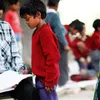How Child Cabinets are weaning students off work and bringing them back to school in Odisha
Poverty forces villagers in Kendrapara district to pull children out of school to work and add to the household income. Awareness and counseling sessions are now sensitising parents to let children continue their education.
The Project Upper Primary School in Pentha, a village prone to cyclones and coastal erosion, under Rajnagar administrative block in Odisha’s Kendrapara district, is in the news. The reason is that Subhasmita Tripathy (13), a Class 8 student, has been nominated for the International Children’s Peace Prize for 2019.
Subhasmita is among 119 child leaders from across the globe nominated for the prize. She was nominated for bringing students who were forced to be irregular to school and improving their age-appropriate learning ability.

Subhasmita, in addition to convincing parents to send their children to school regularly, helps her classmates and younger children improve their learning (Photo by Rakhi Ghosh)
Prone to natural calamities and limited livelihoods, villagers make their children work intermittently to boost their family income. Awareness programmes and Child Cabinets in government schools help students know their rights and learn about the importance of education. This has prompted students like Subhasmita to convince parents to send their children to school regularly.
The importance of education
Subhasmita’s efforts started three years ago when she was in Class 6. Nature’s Club, a local voluntary organization involved in rights and environment related activities in Rajnagar block, in partnership with Save the Children, a non-profit organisation, arranged a meeting in her school.
The meeting was organised to sensitise students, create awareness about their rights, and show how education could bring changes in their lives.
A few days after attending the meeting, Subhasmita realised that a few students of her class and lower classes were not attending school regularly. As the leader of education in the Child Cabinet, she was worried and discussed it with Minati Das, project academic fellow of Nature’s Club.
The Child Cabinet works in the same manner as a government parliament so that children learn about the functioning and hone their leadership skills. Selected children act as head of different departments like education, food, water and sanitation, etc. under a leader named chief minister.
“Suchi, a girl student of Class 5, who was not attending school regularly, was very close to my heart. Every day during prayer I will look for her but often she would be absent,” Subhasmita said. “Once I decided to know the reason and make her attend school regularly, I discussed it with Minati didi.”
Persistence pays
A day after discussing with Das, Subhasmita reached school a little early. At the assembly prayer in the morning, she found that Suchi had not come. So, she went to Suchi’s house and asked her why she did not attend school regularly.

Awareness meetings and being a Child Cabinet leader has sensitised students like Subhasmita to convince parents to send their children to school regularly (Photo by Rakhi Ghosh)
“Before she could answer, her father shouted at me. He said he would decide whether Suchi should attend school or not,” Subhasmita told VillageSquare.in. “Her mother asked who would do Suchi’s share of the household chores if she attended school every day.”
That night, Subhasmita couldn’t sleep. She decided she would do her best to persuade Suchi’s parents to send her to school regularly. With a few of her schoolmates and Minati Das accompanying her, she went to Suchi’s house to convince her parents.
After a month-long persuasion, Suchi's parents agreed to send her to school regularly.
“That gave me confidence to bring other students to school,” said Subhasmita, who now heads the school's Meena Manch, a leadership programme – in lieu of child and women’s development wing of the child cabinet – conducted in every state-run school to increase attendance and safety of girl students.
The reasons for absenteeism
In Pentha, there are 65 households with a population of nearly 400, including a group of Bengali-speaking settlers, who have been in Odisha, settled for generations, and are mainly into fishing. The children of these families and a few native households are regularly absent from school.
The children are engaged in livelihood works in agriculture fields, fish farming, and goat rearing to enhance the family’s income. The number of boys and girls who are not regular to school is almost the same, as both are required to support their family’s earnings. Girls are mostly required for domestic chores and taking care of younger siblings.
“Poverty keeps parents from sending their children to school,” Biraja Prasad Pati, advisor, Nature’s Club told VillageSquare.in. “Rajnagar block is prone to climate change threat and marginalised villagers face difficulties in earning their livelihood. They think an extra hand at work will support their earning and engage them in work.”
Are they dropouts?
There is a difference between out-of-school children and irregular students. According to District Information System for Education (DISE) data, 99.9 percent children attend school regularly. In reality, they do not. The number exists only on paper.
“There are hundreds of students irregular in attending schools. It is not in tribal districts but in Kendrapara villages hit by sea erosion that we found that at least 15 percent children are irregular,” Abhijeet Bhadra, assistant manager, Save the Children, told VillageSquare.in.
As per the Right to Education (RTE) norm, if a child does not attend school for three months at a stretch, the teacher should visit his/her home. If the child does not attend school regularly, even after the parents have been counseled, the teacher will take the help of a member of the panchayat, then write a letter to the block education officer (BEO). If the child still does not come to school, she will be considered a dropout.

Pentha is one of the villages prone to cyclones and sea erosion, where students do not attend school regularly, but work to support their family financially (Photo by Rakhi Ghosh)
During this three-month period, if the child attends school even once, s/he will not be considered a dropout.
“There is a rule to bring back irregular students, understand the reason for being irregular and counsel them to attend regularly. But in reality no teacher does this, citing workload,” said Bhadra.
Counseling does work
Some schools do counsel parents. Birju was good at studies. His father migrated to another state and stopped sending money after a few months. Birju was the only male member, and his grandfather forced him to work in agriculture fields and tend to cows, to earn and support the family.
“After regular counseling the grandfather agreed to send Birju to school,” Samarendra Sahu, teacher at Pentha Project Upper Primary School, told VillageSquare.in. “At parent–teacher meetings, we regularly counsel parents, but as they are not financially sound they send their children to work.”
Bringing students to school
In 2016, when Save the Children started working in this area, they found the attendance of students quite low than the actual enrollment. Also, during mid-day meal, a few children came, had their meal, and went back to work.
“We decided to sensitise school children about their rights and strengthened the Child Cabinet to bring back children who were forced to be irregular,” said Bhadra. Though
Child Cabinets exist in every government school, but they do not function. Strengthening the Child Cabinet in 40 state-run schools of Rajnagar block has helped to bring irregular students back to school.
The role of Child Cabinets
Prasannapur Project Upper Primary School in Rajnagar gave the appearance of full attendance. “Though the total strength is 72, some students do not attend regularly,” Kailash Chandra Rout, headmaster, told VillageSquare.in. “Strengthening the Child Cabinet helped make them attend school regularly and improve their age-appropriate learning.”
“Children are also part of the school management committee but due to fear they would not raise their voice. Now, the Child Cabinet has empowered them to speak for their rights. Whether it’s quality of food, education or safety, children are raising their voice,” said Biraja Prasad Pati.
After observing the success of Child Cabinets in the 40 state-run schools, BEO of Rajnagar block is planning to strengthen it in other schools too. In three years, Subhasmita has convinced parents of 12 students to send them to school regularly. She also helps to improve their learning ability.
“If she gets International Children’s Peace Prize it will motivate her to reach out to other children and shape their future,” Keshab Charan Palei, the village head, told VillageSquare.in. “Because only education can help them evade poverty.”
(Edited by Teja Lele Desai)









